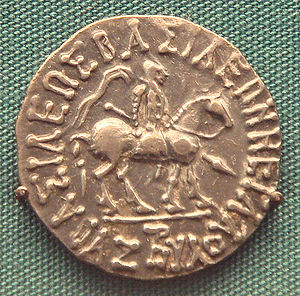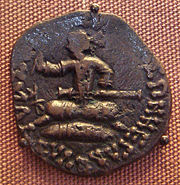
Azes I
Encyclopedia

India
India , officially the Republic of India , is a country in South Asia. It is the seventh-largest country by geographical area, the second-most populous country with over 1.2 billion people, and the most populous democracy in the world...
.
History
Although MauesMaues
Maues was an Indo-Scythian king who invaded the Indo-Greek territories.-Conqueror of Gandhara:...
and his successors had conquered the areas of Gandhara
Gandhara
Gandhāra , is the name of an ancient kingdom , located in northern Pakistan and eastern Afghanistan. Gandhara was located mainly in the vale of Peshawar, the Potohar plateau and on the Kabul River...
, as well as the area of Mathura from 85 BCE, they were unsuccessful against the Indo-Greek kings remaining behind the Jhelum River
Jhelum River
Jehlum River or Jhelum River , ) is a river that flows in India and Pakistan. It is the largest and most western of the five rivers of Punjab, and passes through Jhelum District...
in eastern Punjab
Punjab region
The Punjab , also spelled Panjab |water]]s"), is a geographical region straddling the border between Pakistan and India which includes Punjab province in Pakistan and the states of the Punjab, Haryana, Himachal Pradesh, Chandigarh and some northern parts of the National Capital Territory of Delhi...
.
The Indo-Greek Hippostratos
Hippostratos
Hippostratos was an Indo-Greek king who ruled central and north-western Punjab and Pushkalavati. Bopearachchi dates Hippostratos to 65 to 55 BCE whereas R.C...
(65-55 BCE) finally lost to Azes I after a long resistance. Some coins of Azes I depict the god Poseidon
Poseidon
Poseidon was the god of the sea, and, as "Earth-Shaker," of the earthquakes in Greek mythology. The name of the sea-god Nethuns in Etruscan was adopted in Latin for Neptune in Roman mythology: both were sea gods analogous to Poseidon...
vanquishing a horned river god, suggesting a naval victory over a river, probably the Jhelum.
The Azes Era

58 BC
Year 58 BC was a year of the pre-Julian Roman calendar. At the time, it was known as the Year of the Consulship of Piso and Gabinius...
and believe it is the same as the later era known as the Malwa or Vikrama era. However, a recently discovered inscription dated in both the Azes and the Greek era suggests that actually this is not the case. The inscription gives the relationship Azes = Greek + 128. It is believed that the Greek era may have begun in 173 BCE, exactly 300 years before the first year of the Era of Kanishka
Kanishka
Kanishka ) was an emperor of the Kushan Empire, ruling an empire extending from Bactria to large parts of northern India in the 2nd century of the common era, and famous for his military, political, and spiritual achievements...
. If that is the case then the Azes era would begin in about 45 BC
45 BC
Year 45 BC was either a common year starting on Thursday, Friday or Saturday or a leap year starting on Friday or Saturday and the first year of the Julian calendar and a leap year starting on Friday of the Proleptic Julian calendar...
.
According to Senior, Azes I may have been identical with Azes II
Azes II
Azes II , may have been the last Indo-Scythian king in northern Indian subcontinent . After the death of Azes II, the rule of the Indo-Scythians in northwestern India and Pakistan finally crumbled with the conquest of the Kushans, one of the five tribes of the Yuezhi who had lived in Bactria for...
, due to the discovery of an overstrike of the former over the latter.
Other coins
| Preceded by: Indo-Scythian king Spalirises Spalirises Spalirises was an Indo-Scythian "Great king" of the 1st century BCE. He was the brother of Vonones , and probably identical with Spalahores.... (In Arachosia Arachosia Arachosia is the Latinized form of the Greek name of an Achaemenid and Seleucid governorate in the eastern part of their respective empires, around modern-day southern Afghanistan. The Greek term "Arachosia" corresponds to the Iranian land of Harauti which was between Kandahar in Afghanistan and... and Gandhara Gandhara Gandhāra , is the name of an ancient kingdom , located in northern Pakistan and eastern Afghanistan. Gandhara was located mainly in the vale of Peshawar, the Potohar plateau and on the Kabul River... ) Indo-Greek king: Telephos King Telephos Telephos Euergetes, "the Benefactor", was a late Indo-Greek king who seem to have been one of the weak and brief successors of Maues. Bopearachchi dates Telephos between 75-70 BCE and places him in Gandhara, Senior to circa 60 BCE and suggests that he ruled in some parts of Pushkalavati or even... (In the western Punjab Punjab region The Punjab , also spelled Panjab |water]]s"), is a geographical region straddling the border between Pakistan and India which includes Punjab province in Pakistan and the states of the Punjab, Haryana, Himachal Pradesh, Chandigarh and some northern parts of the National Capital Territory of Delhi... ) Indo-Greek king: Hippostratos Hippostratos Hippostratos was an Indo-Greek king who ruled central and north-western Punjab and Pushkalavati. Bopearachchi dates Hippostratos to 65 to 55 BCE whereas R.C... |
Indo-Scythian Ruler (57-35 BCE) |
Succeeded by: Azilises Azilises Azilises was an Indo-Scythian king who ruled in the area of Gandhara.-Coinage:Azilises issued some joint coins with Azes, where Azes is presented as king on the obverse , and Azilises is introduced as king on the obverse in kharoshthi .-See... |
See also
- YuezhiYuezhiThe Yuezhi, or Rouzhi , also known as the Da Yuezhi or Da Rouzhi , were an ancient Central Asian people....
- Greco-Bactrian KingdomGreco-Bactrian KingdomThe Greco-Bactrian Kingdom was the easternmost part of the Hellenistic world, covering Bactria and Sogdiana in Central Asia from 250 to 125 BC...
- Indo-Greek KingdomIndo-Greek KingdomThe Indo-Greek Kingdom or Graeco-Indian Kingdom covered various parts of the northwest regions of the Indian subcontinent during the last two centuries BC, and was ruled by more than 30 Hellenistic kings, often in conflict with each other...
- Indo-Parthian KingdomIndo-Parthian KingdomThe Gondopharid dynasty, and other so-called Indo-Parthian rulers, were a group of ancient kings from present day eastern Afghanistan and Pakistan who ruled India, during or slightly before the 1st century AD...
- Kushan EmpireKushan EmpireThe Kushan Empire originally formed in the early 1st century AD under Kujula Kadphises in the territories of ancient Bactria on either side of the middle course of the Oxus in what is now northern Afghanistan, Pakistan, and southern Tajikistan and Uzbekistan.During the 1st and early 2nd centuries...

